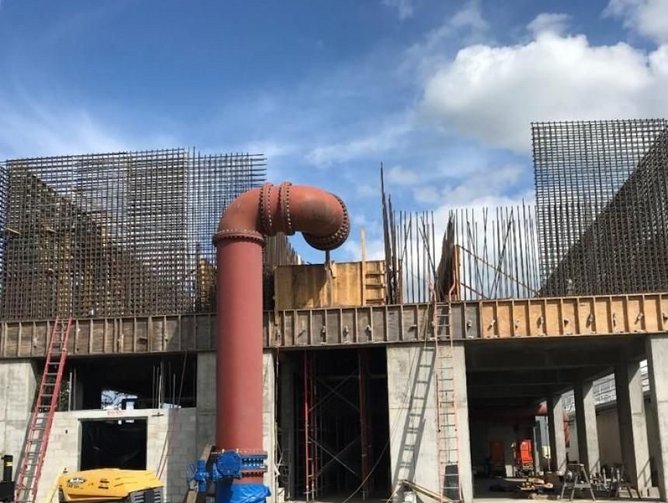Manatee County Utilities: developing water solutions for the future
The need for clean water worldwide remains vital, and this is never truer than in the US. With an increasingly growing population, it has become an area of prominence and all the more integral to President Trump’s development of America’s infrastructures.
“Utilities are focusing on replacing existing and aging infrastructure, whether that be out in the system, or actually at treatment facilities themselves,” explains Mark Simpson, Water Division Manager at Manatee County Utilities. “People see the need to reinvest where there are limited resources, and management programs make sure that we receive the most efficient and effective use of infrastructure investment.”
At present, residents of Manatee County, Sarasota County, the cities of Palmetto and Bradenton, and the municipalities on the barrier islands obtain all or a portion of their water supply via the Lake Manatee Water Treatment Plant. Catering to over 350,000 civilians and processing over 40mn gallons of water each day, the facility and subsequent filtration technology is something of which the company places increased emphasis with regards to maintenance. With the dam now reaching its 50th year, “maintaining the structure means investing in that infrastructure to make sure it can last another 50 to 100 years,” Simpson adds.
The upgrade of the facility will therefore support Manatee County’s ambitions to deliver clean water for the foreseeable future and ensure the county remains compliant with ever more strict US Environmental Protection Agency requirements.
The Plant has two treatment segments – one for its surface water (54 MGD capacity) and the other for groundwater (30 MGD capacity). The upgrade will include a new Ultrafiltration Membrane System (UF), which will be implemented through the company’s partnership with GE Water & Process Technologies, for the surface water treatment segments. The agreement will see the installation of 12 membrane trains, retrofitted into existing sand filter basins. Being able to operate the UF in a partial siphon mode will ultimately create savings with escalating pumping costs. The plant is designed to operate at over 96% recovery upon completion.
"The ZeeWeed 1000 membrane consistently outperforms conventional filtration technology while meeting or exceeding regulatory requirements, regardless of source water quality,” comments Kevin Cassidy, Global leader of engineered systems for GE Water & Process Technologies. “It produces superior water quality and is virtually unaffected by variable raw water quality, which makes it the ideal technology to use for the upgrade of the Lake Manatee Water Treatment Plant.”
Further developments
Another improvement has led to the construction of a new Biological Treatment Unit (BTU), which will house a new concrete facility, heating, ventilation and air conditioning (HVAC) and electrical system, concrete filter tanks, biological treatment filters and an on-site sanitary sewer collection system.
“The BTU is primarily designed for the removal of off-taste causing compounds created by algal growth in Lake Manatee,” Simpson notes. “These compounds have not been found to be harmful, but they do create an earthy, musty taste that customers find objectionable, and it causes them to question the water quality. It also leads to additional expenses such as purchasing additional bottled water.
“So, the BTU allows us to remove these compounds at a much greater efficiency than our current method of adding powdered activated carbon (PAC),” he adds. “The cost for PAC use at our facility is at a million dollars a year.”
Additionally, both construction projects will be integrated with the transformation and replacement of the SCADA control system, which allows Manatee County to control the plant from the central hub. “This upgrade will occur in the next year and a half,” adds Simpson, “as well as a maintenance management system (CMMS), which will enable the organization to optimize its reinvestment resources in both the water system and the waste water system.”
Ongoing support
Manatee County has built strong relationships with external partners throughout the ongoing development works. Carollo Engineers, in conjunction with GE, are completing the design for the UF project and are now working on Manatee County’s SCADA management system. Vogel Brothers is the general contractor building the BTU.
“This is an opportunity for local workers to work on a project that will have a positive effect on the community, and enhance the quality of life for civilians,” Simpson says.
However, the upgrade of Manatee County’s water treatment facility is by no means low risk, nor an easy task. With the potential to impact thousands of civilians, Simpson explains that such pressure can be daunting. The operation runs 24-7, even in adverse weather conditions, such as with Hurricane Irma, which heavily impacted ongoing operations.
“Maintaining operations is a consistent challenge,” he states. “During Hurricane Irma everybody was on emergency operation protocols, which required around-the-clock access and action by our teams in order to make sure that we kept the dam together and our facility operational.”
Long-term prospects
Working within the water industry for over 30 years, Simpson has seen how the industry has transformed over the years, but stresses how it remains an important subject not only in the US, but on a global scale. Nonetheless, he concludes that going forward, the way in which water projects are financed and agreed upon is also set to change.
“Over the next five years, the water industry will continue to move towards looking for additional associates through public-private partnerships for reinvestment in infrastructure.
“What will happen then is the focus on how we can adjust, react or change our systems to make them less susceptible to climate change and sea level rise. Especially here in Florida, there's going to be a big impact on that, where a large portion of the population of the United States lives within several miles of the coast line.
“I think that that's something that's really going to take off in the next five years. You’ll also see a lot of work done as to what utilities can do and plans to implement some of those changes.”



